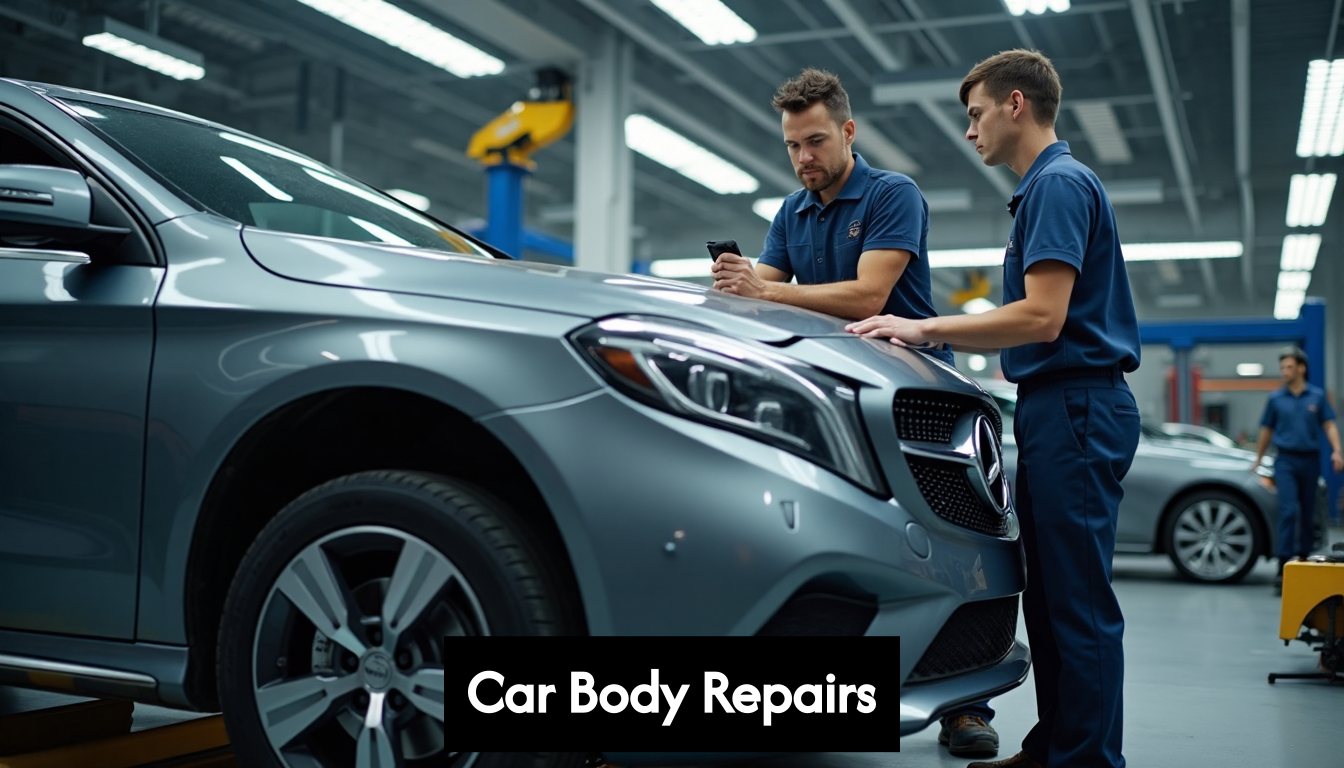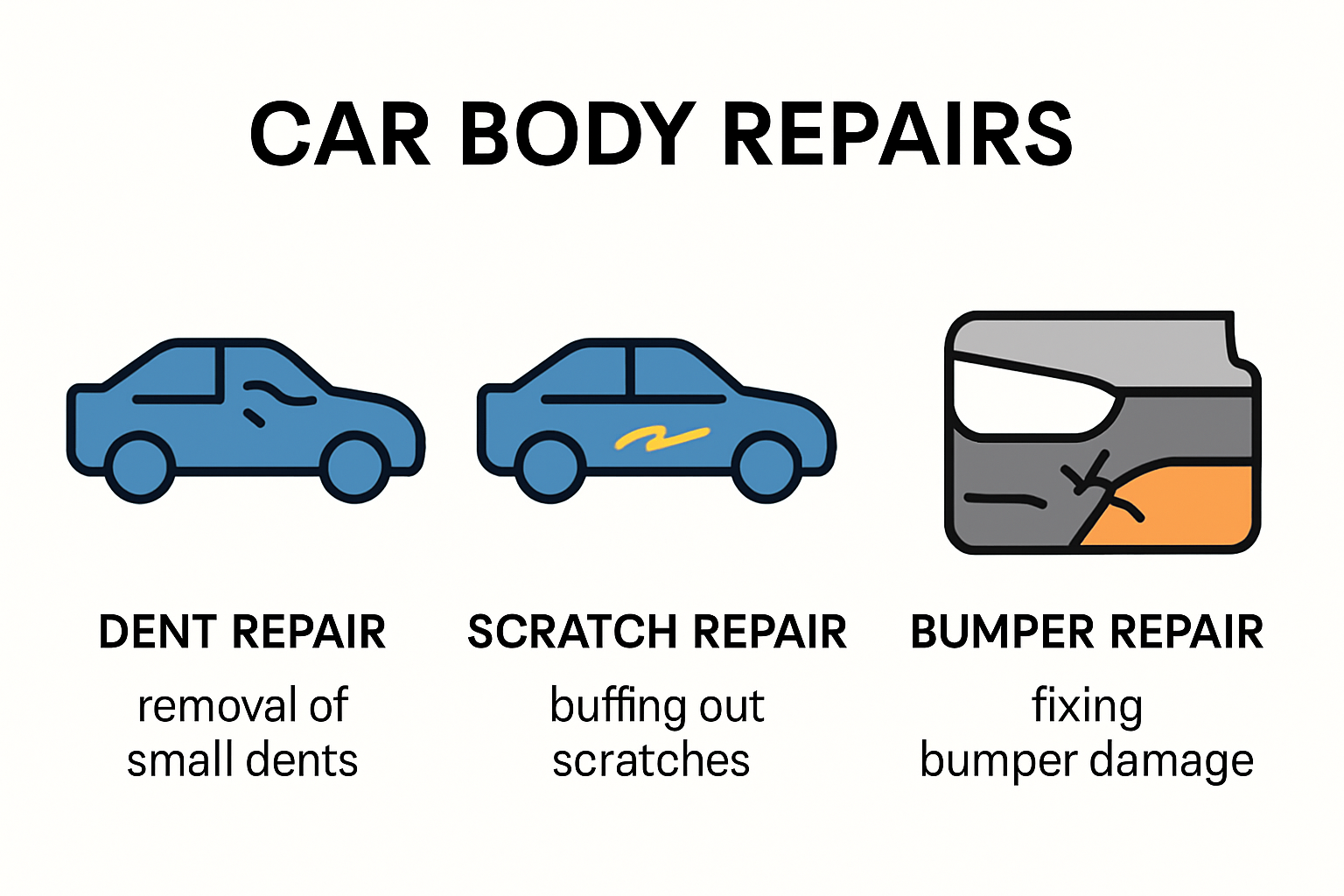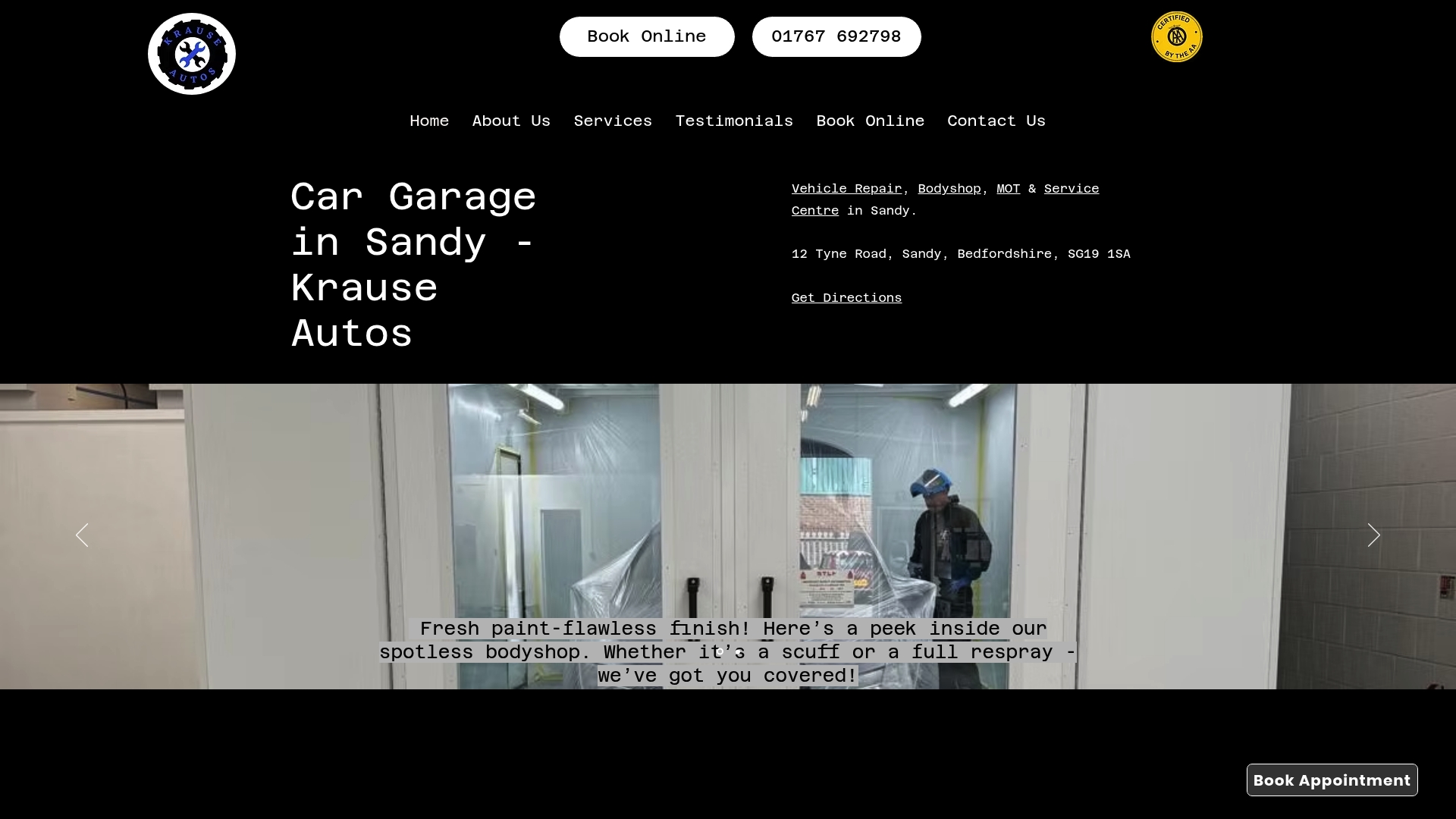Types of Car Body Repairs: A Practical Guide for Every Driver 2025
- coledem
- Jun 15
- 9 min read
Updated: Jun 22
Car body repairs are something almost every driver faces sooner or later, whether it’s a scuffed bumper or an unsightly dent. Across the UK, the vehicle body repair market is now valued at over £9 billion, a figure that’s only climbing as more cars hit the road each year. Now here’s the surprise. Most people assume the most expensive part of any repair is the labour. Not even close. The reality is, parts alone now make up 52% of total repair costs, dwarfing labour charges and making your repair bill harder to predict than ever. This flips the old advice on its head and calls for a new way to approach car repairs—one that’s more practical, better informed, and cost-aware. Here’s what every driver should know before stepping into a garage.
Table of Contents
Quick Summary
Common Types of Car Body Repairs Explained
Car body repairs are an essential aspect of vehicle maintenance that every driver will encounter at some point. Understanding the most common types of body repairs helps you make informed decisions about your vehicle’s care and potentially save money in the long run.
Dent and Scratch Repairs: Restoring Your Vehicle’s Appearance
Minor dents and scratches are among the most frequent types of car body damage. Paintless Dent Repair (PDR) has emerged as a revolutionary technique for addressing these issues. According to Road Web UK, PDR offers a cost-effective solution for fixing minor dents where the paint remains intact. This method involves carefully massaging the dent from behind the panel, restoring the original shape without the need for repainting.
Scratch repairs vary in complexity and cost. As Launder Coachworks reports, these repairs can range from £100 to £500, depending on the depth and location of the scratch. Surface-level scratches might require only a simple polish, while deeper scratches may need more extensive work involving color matching and repainting.

Advanced Repair Techniques: SMART Repairs
SMART repairs (Small to Medium Area Repair Technology) represent a modern approach to car body maintenance. JS Coachworks explains that these localised fixes focus on addressing minor damage with precision and efficiency. This technique is particularly valuable for:
- Targeted Repairs
: Addressing specific areas of damage without full panel replacement
- Cost Effectiveness
: Significantly cheaper than traditional body shop repairs
- Time Efficiency
: Repairs can often be completed in a matter of hours
Typically, SMART repairs cover a range of issues including small dents, paint chips, bumper scuffs, and minor panel damage. The process involves carefully blending and matching paint to ensure a seamless repair that maintains the vehicle’s original appearance.
Bumper and Panel Repairs: Handling More Significant Damage
Bumper repairs are another common type of car body work. According to industry data, these repairs can cost between £150 and £600, depending on the extent of the damage. The complexity increases with the type of bumper - plastic bumpers are often easier to repair, while carbon fibre or specialised material bumpers may require more intricate work.
Panel repairs become necessary when damage extends beyond simple dents or scratches. This might involve:
Straightening bent panels
Replacing severely damaged sections
Realigning body panels to ensure proper fit
Repainting to match the original vehicle colour
Whether you’re dealing with a minor scratch or more significant body damage, understanding these common repair types can help you approach car maintenance more confidently. Each type of repair requires specific skills and techniques, which is why it’s crucial to choose a reputable and experienced body repair specialist who can assess and address your vehicle’s specific needs.
Remember, prompt attention to body damage can prevent more extensive and expensive repairs down the line. Regular inspection and immediate action when damage occurs is the key to maintaining your vehicle’s appearance and value.
Choosing the Right Repair for Your Car
Selecting the appropriate repair method for your vehicle is crucial to maintaining its value, safety, and aesthetic appeal. Understanding the factors that influence repair decisions can help you make informed choices and potentially save money in the long term.

Assessing Damage Severity and Repair Options
The first step in choosing the right repair involves a thorough assessment of the damage. JS Coachworks highlights that damage severity determines whether a repair or replacement is the most appropriate solution. Minor surface damage often qualifies for less invasive repair techniques, while significant structural damage may require complete panel replacement.
Paintless Dent Repair (PDR) emerges as an excellent option for specific types of damage. This technique is particularly effective for:
Hail damage
Small door dings
Minor surface dents without paint damage
PDR offers several advantages, including preserving the original paint finish and being more cost-effective than traditional repair methods.
Cost Considerations and Repair Strategies
Cost plays a significant role in repair decisions. According to Launder Coachworks, repair costs can vary dramatically:
Dent repairs: £50 to £200
Bumper repairs: £150 to £600
Panel replacements: Potentially more expensive
Drivers must weigh the cost of repair against the vehicle’s overall value. For older vehicles, extensive repairs might not make financial sense, whereas newer cars benefit from comprehensive maintenance. Consider factors such as:
Vehicle age
Current market value
Potential impact on resale value
Insurance coverage
Professional Assessment and Long-Term Vehicle Integrity
JS Coachworks emphasizes that full panel replacement becomes necessary when damage compromises the vehicle’s structural integrity. This is particularly critical for safety-related components where structural strength is paramount.
Key considerations for professional repair assessment include:

Structural damage evaluation
Paint and finish matching
Potential hidden damage
Long-term durability of repair
Professional technicians can provide detailed insights into the most appropriate repair strategy. They assess not just the visible damage but also potential underlying issues that might compromise your vehicle’s safety and performance.
Whether you’re dealing with a minor scratch or significant body damage, the right repair approach depends on multiple factors. Professional evaluation, cost analysis, and understanding the extent of damage are critical in making an informed decision. Always consult with experienced automotive body repair specialists who can provide comprehensive advice tailored to your specific situation.
Remember, timely and appropriate repairs not only maintain your vehicle’s appearance but also protect its structural integrity and long-term value. Investing in quality repairs now can prevent more expensive problems in the future.
Costs, Timelines and What to Expect
Understanding the financial and temporal aspects of car body repairs helps drivers plan effectively and set realistic expectations. The automotive repair landscape is continuously evolving, with costs and timelines influenced by various factors that every vehicle owner should comprehend.
Understanding Repair Market Dynamics
ARC360 reports that the UK vehicle body repair market is currently valued at over £9 billion in 2024. This substantial figure reflects the complexity and ongoing demand for professional automotive repair services. Recent industry trends reveal significant shifts in repair economics that directly impact vehicle owners.
According to Body Shop Magazine, vehicle repair costs have experienced a notable increase:
Overall repair costs rose by 6.7% in the last year
Repair expenses are 25.7% higher compared to 2020
Electric vehicle repairs are approximately 15% more expensive than average
These increases stem from multiple factors, including more complex vehicle technologies, advanced materials, and sophisticated repair techniques.
Breakdown of Repair Expenses
The financial landscape of car body repairs is intricate. Body Shop Magazine provides a detailed breakdown of repair expenses:

- Parts Costs
: Now account for 52% of total repair expenses
- Parts Inflation
: 7.3% increase in the last year
- Cumulative Parts Cost
: 29% increase since 2020
- Labour Rates
: 20.8% rise over four years
Drivers should anticipate these cost factors when budgeting for repairs. The increasing complexity of modern vehicles, particularly electric and hybrid models, contributes to these rising expenses. Advanced materials, sophisticated electronics, and precision engineering demand more specialised repair techniques.
Repair Timelines and Expectations
Repair duration varies significantly based on damage complexity. Minor repairs like paintless dent removal might take just a few hours, while more extensive bodywork could require several days or even weeks. Factors influencing repair timelines include:
Extent and type of damage
Availability of replacement parts
Complexity of repair techniques required
Workshop current workload
For electric vehicles, repair times can be longer due to additional technological considerations and specialised repair requirements. Drivers should maintain open communication with their chosen repair facility to get accurate time estimates.
When scheduling repairs, consider these practical tips:
Request a detailed written estimate
Ask about potential additional costs
Understand the repair process step by step
Confirm warranty or guarantee on repair work
Transparency between the vehicle owner and repair technicians is crucial. A comprehensive initial assessment helps set accurate expectations regarding both cost and timeline. Professional workshops will provide clear, detailed information about the proposed repair strategy.
Remember that investing in quality repairs protects your vehicle’s value, safety, and long-term performance. While costs might seem significant, timely and professional repairs prevent more expensive damage in the future. Always prioritise reputable repair services that offer clear communication and demonstrate expertise in handling your specific vehicle type.
Tips for Finding a Reliable Repair Garage
Choosing the right repair garage is crucial for maintaining your vehicle’s performance, safety, and longevity. With numerous options available, finding a trustworthy and competent automotive repair service can seem challenging, but several key strategies can help you make an informed decision.
Professional Accreditations and Credentials

Which? Trusted Traders recommends focusing on garages with recognized professional accreditations. These credentials serve as a reliable indicator of quality and professionalism. Key accreditations to look for include:
- Motor Ombudsman Approval
: Indicates adherence to strict customer service standards
- IMI (Institute of the Motor Industry) Certification
: Demonstrates professional training and expertise
- Manufacturer-Specific Certifications
: Shows specialized knowledge for particular vehicle brands
Adderley Green Garage emphasizes that these accreditations are not just decorative badges but represent a commitment to ongoing professional development and customer satisfaction.
Transparency and Communication
A reliable repair garage distinguishes itself through clear, upfront communication. Which? Trusted Traders suggests several critical steps to ensure transparency:
- Written Quotes
: Always request a detailed written estimate
- Comprehensive Quote Breakdown
: Ensure the quote includes:
Parts costs
Labour charges
VAT
- Explanation of Repairs
: A trustworthy garage will explain issues in understandable terms
- Proof of Necessity
: Request clear explanations for recommended repairs
Transparency helps build trust and prevents unexpected costs. A reputable garage will be willing to discuss their proposed repairs, answer your questions, and provide detailed information about the work required.
Research and Due Diligence
Before committing to a repair garage, invest time in thorough research:
- Online Reviews
: Check multiple platforms for customer experiences
- Personal Recommendations
: Ask friends, family, and colleagues
- Social Media and Local Forums
: Gather community insights
- Initial Consultation
: Many garages offer free initial assessments
Pay attention to:
Consistency in positive feedback
How the garage handles negative reviews
Response times and communication quality
Range of services offered
Additionally, verify the garage’s experience with your specific vehicle type. Some workshops specialize in certain brands or vehicle categories, which can be advantageous for complex repairs.
Remember that the cheapest option is not always the best. A slightly higher cost might represent better quality work, more comprehensive warranties, and long-term reliability. Prioritize garages that demonstrate expertise, use quality parts, and provide clear, honest communication.
Ultimately, finding a reliable repair garage is about building a long-term relationship. A garage that treats your vehicle with care, provides transparent service, and demonstrates technical expertise will be an invaluable partner in maintaining your vehicle’s performance and value.
Frequently Asked Questions
What are the most common types of car body repairs?
The most common types of car body repairs include dent and scratch repairs, bumper and panel repairs, and advanced SMART repairs, which address specific damages with precision and efficiency.
How much does it typically cost to repair dents and scratches?
Costs for dent repairs range from £50 to £200, while scratch repairs can vary significantly, costing between £100 and £500 depending on their depth and location.
What is Paintless Dent Repair (PDR) and how does it work?
Paintless Dent Repair (PDR) is a cost-effective method used to fix minor dents without repainting. It involves massaging the dent from behind the panel to restore its original shape, preserving the original paint finish.
How do I choose the right garage for car body repairs?
To choose a reliable garage, look for professional accreditations, ensure transparency in communication, and conduct thorough research, including checking online reviews and recommendations from friends and family.
Restore Your Car’s Look and Value with Expert Body Repairs in Bedfordshire
Unexpected dents scratches or bumper damage can leave you frustrated and worried about your car’s long-term value and safety. After reading about paintless dent repair SMART methods and the rising cost of parts and repairs you might be feeling overwhelmed about where to find transparent honest help for your car bodywork needs. At Krause Autos in Sandy our new bodywork centre bridges the gap between costly main dealer prices and the personal care of a trusted local garage. We handle everything from minor scratches to bumper and panel repairs always with a clear assessment and no hidden costs. Visit our main site to see our full range of services or contact our team for tailored advice.
Why wait until minor damage becomes expensive to fix? Discover the convenience and quality of comprehensive vehicle care all under one roof at Krause Autos. Get your free honest quote from a family-run team committed to keeping your car in top shape. Take the next step now and visit Krause Autos for expert bodywork repairs that protect your investment and give you peace of mind.






Comments